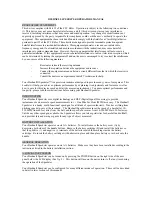
Nothing
Comes Close to a Cobra
®
English
10
11
Understanding LIDAR
Your Detector
Intro
Operation
Customer
Assistance
Warranty
Notice
Main Icons
Secondary Icons
Your Detector
Intro
Operation
Customer
Assistance
Warranty
Notice
Main Icons
Secondary Icons
Radar Alerts
•
In
More
detail mode the radar band, signal strength and frequency of the detected
radar signal will be displayed.
If you are a new user of radar detectors, you may want to use the Less detail
mode. In this mode the display will only show one, two, or three bars which
indicate how likely the alert is to be a police radar or laser gun. This threat level
indication takes into account the laser or radar band, strength, and frequency of
the detected signal.
Level
Display
Threat
1
Low
2
Medium
3
High
Laser Alerts
•
With Laser signals you will always receive a full strength alert. In More Detail
mode the word
Laser
will be shown on the display along with the pulse rate of
the Laser signal. In Less Detail mode three signal strength bars will be shown.
Radar Band
Frequency
Signal Strength
LOW
MED
HIGH
Understanding Radar and Laser
•
Radar Speed Monitoring Systems
Three band frequencies have been approved by the Federal Communications
Commission (FCC) for use by speed monitoring radar equipment:
X band
10.525 GHz
K band
24.150 GHz
Ka band
33.400 – 36.00 GHz
Your detector detects signals in all three radar bands.
VG-2
VG-2
is a “detector detector” that works by detecting low-level signals emitted
by most radar detectors. Your detector does not emit signals that can be detected
by VG-2, but does detect VG-2 signals and will alert you when a device is in use
near your vehicle.
Spectre RDD’s
Your detector can be spotted by Spectre IV+ RDDs, but is invisible to VG-2 and
Spectre I RDDs. You can choose whether you want to be alerted to VG-2 and
Spectre I & IV+ RDD signals. The factory setting for VG-2 and Spectre I & IV+
alerts is Off. It is recommended to leave these Off unless you are concerned
about being monitored for having a radar detector. For non-commercial
vehicles, radar detectors are legal in the U.S. with the exception of Viginia and
Washington D.C.
LIDAR (Laser)
The correct name for the technology that most people refer to as laser is
actually
LIDAR
, which stands for Light Detection and Ranging.
LIDAR operates much like radar. Its signal spreads out like a radar signal, though
not as widely. Unlike radar, LIDAR must have a clear line of sight to its target
vehicle throughout the entire measurement interval. Obstructions such as sign
posts, utility poles, tree branches, etc., will prevent valid speed measurement.
Some common questions about LIDAR include:
n
Does weather have any affect on LIDAR?
Yes. Rain, snow, smoke, fog or airborne dust particles will reduce the
effective range of LIDAR and can, if dense enough, prevent its operation.
n
Can LIDAR operate through glass?
Yes. Newer LIDAR guns can obtain readings through most types of glass.
However, the laser pulse also can be received through glass to trigger an
alarm by your detector.
n
Can LIDAR operate while in motion?
No. Because LIDAR operates by line of sight, the person using it cannot drive
the vehicle, aim and operate the gun all at the same time.
n
Is it legal for police to use LIDAR?
Yes, LIDAR is allowed to be used in all 50 States by police. Your detector
detects LIDAR (laser).
Understanding Radar
RAD500G_MANL.indd 10-11
4/20/17 4:04 PM





























